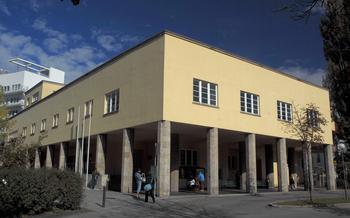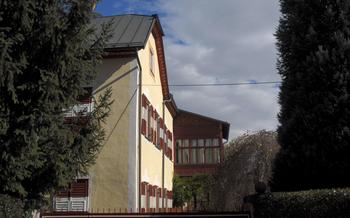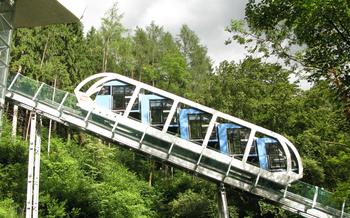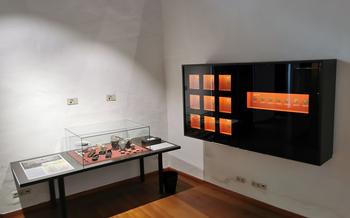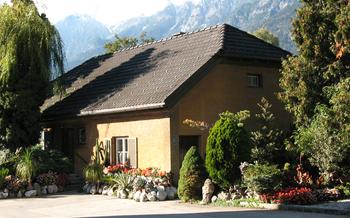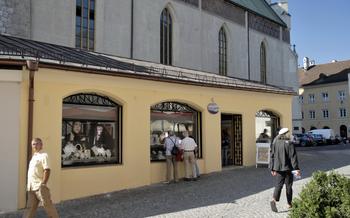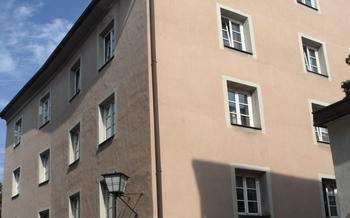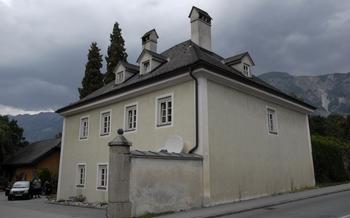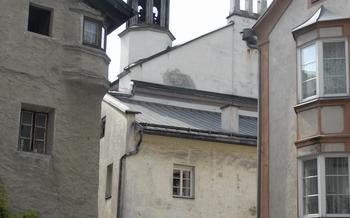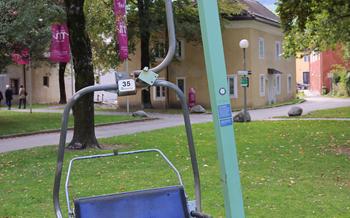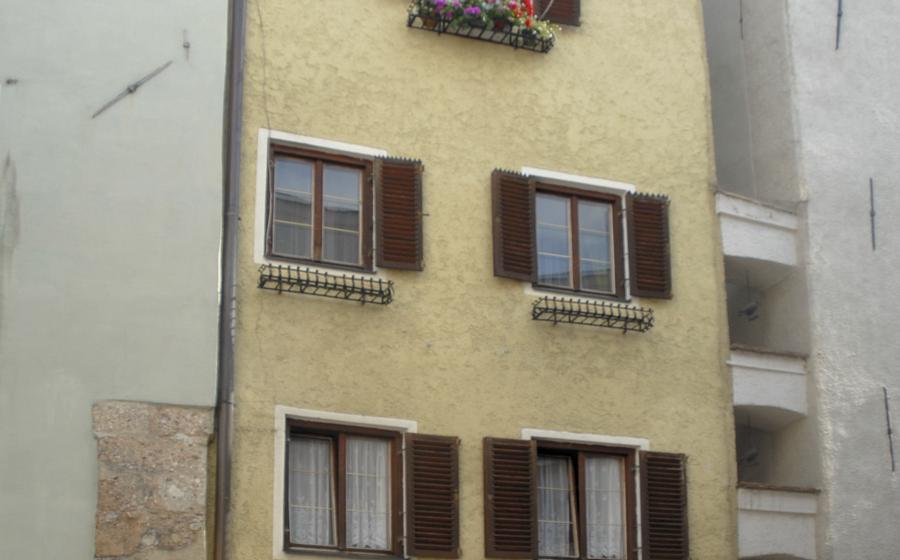
Hall Mint Museum (Münzergasse)
- A Journey to Hall in Tirol: A Haven for History and Charm
- Hall Mint Museum: Unveiling a Legacy of Coinage
- A Glimpse into the World of Coin Production
- The Thaler: A Symbol of Monetary Prowess
- Exploring the Museum's Collections
- Unraveling the Secrets of Counterfeiting
- Interactive Activities for Visitors
- Hall Mint Museum: A Repository of Knowledge
- Events and Exhibitions at the Museum
- Architectural Heritage of the Mint Building
- Visitor Information and Accessibility
- Souvenirs and Mementos
- Exploring Hall in Tirol Beyond the Mint Museum
- Practical Tips for Visitors
- Insider Tip: Unveiling the Hidden Gem
A Journey to Hall in Tirol: A Haven for History and Charm
Nestled in the heart of the Tyrolean Alps, Hall in Tirol stands as a testament to the region's rich history and captivating charm. This medieval town, with its cobblestone streets, beautifully preserved buildings, and stunning Alpine backdrop, offers visitors a glimpse into a bygone era.
Hall in Tirol boasts a cultural heritage that spans centuries, leaving behind a legacy of art, architecture, and tradition. From the imposing Hall Mint, a relic of the town's monetary significance, to the historic churches and monasteries, each corner of Hall in Tirol whispers tales of its glorious past.
The town's strategic location at the crossroads of trade routes contributed to its prosperity and cultural exchange. This vibrant melting pot of cultures left an indelible mark on Hall in Tirol, shaping its unique identity and charm. Whether wandering through its picturesque streets, admiring its architectural wonders, or savoring the local cuisine, visitors are transported back in time, experiencing the essence of this enchanting Tyrolean town.
Hall Mint Museum: Unveiling a Legacy of Coinage
The Hall Mint Museum, nestled in the heart of Hall in Tirol, Austria, is a treasure trove of numismatic history and craftsmanship. Established in the 13th century, the mint played a pivotal role in minting coins for the Austrian Empire and beyond. Its legacy extends far beyond the walls of the museum, shaping the monetary landscape of Europe and leaving an enduring mark on the world of coinage.
Over the centuries, the Hall Mint witnessed the evolution of coinage techniques, from the primitive methods of hammering and casting to the introduction of advanced machinery and precision minting. The museum's collection houses a vast array of coins and artifacts that chronicle this transformation. Visitors can marvel at the intricate designs, diverse denominations, and historical significance of these monetary treasures.
The Hall Mint Museum is not merely a repository of coins; it is a testament to the artistry and ingenuity of the mint masters and craftsmen who dedicated their lives to the creation of these tiny works of art. Their skill and dedication are evident in every coin produced, from the meticulously engraved dies to the perfectly struck impressions.
The museum's exhibits provide a fascinating glimpse into the world of coin production, showcasing interactive displays that demonstrate the minting process and allow visitors to witness the creation of coins firsthand. Educational panels and multimedia presentations shed light on the history, significance, and cultural impact of coinage.
Among the museum's highlights is the renowned Thaler, a silver coin that gained international prominence during the 16th century. The Thaler's influence extended far beyond its monetary value, becoming a symbol of economic power and shaping the global economy. Visitors can learn about the Thaler's historical significance and its role in international trade, gaining insights into the intricate workings of the monetary system.
The Hall Mint Museum is a must-visit destination for anyone interested in numismatics, monetary history, or simply the artistry and craftsmanship that goes into creating coins. Its collection, exhibits, and interactive displays provide a comprehensive and engaging journey through the world of coinage, offering visitors a unique glimpse into the legacy of the Hall Mint.
A Glimpse into the World of Coin Production
The Hall Mint Museum provides visitors with a unique opportunity to delve into the intricate world of coin production. Interactive exhibits showcase the entire minting process, from the initial design and engraving of the dies to the striking and finishing of the coins. Visitors can witness skilled artisans demonstrating traditional coin-making techniques, using centuries-old tools and machinery. The museum also offers the chance to witness the creation of coins firsthand, as the mint still produces commemorative coins and medals on a limited basis. This educational and immersive experience is a delight for visitors of all ages, offering a behind-the-scenes look at the fascinating process of transforming precious metals into currency.
The Thaler: A Symbol of Monetary Prowess
The Hall Mint Museum pays homage to the renowned Thaler, a silver coin that played a pivotal role in international trade during the 16th and 17th centuries. Minted in Hall in Tirol from 1486 onwards, the Thaler gained widespread recognition and became a symbol of monetary prowess. Its name, derived from the German word "Tal," meaning valley, reflects the coin's origins in the Tyrolean Alps.
The Thaler's popularity stemmed from its consistent quality and weight, ensuring its acceptance across borders. It became the standard unit of account in many European countries and facilitated trade between nations. The coin's reputation for reliability contributed to the economic stability of the Austrian Empire and beyond.
The Thaler's influence extended far beyond the borders of Austria. It became a global currency, adopted by countries in Europe, the Americas, and Asia. Its widespread use facilitated international trade and commerce, contributing to the rise of global capitalism.
The Thaler's legacy lives on today in the form of modern currencies such as the dollar, euro, and pound. These currencies trace their lineage back to the Thaler, demonstrating the enduring impact of this iconic coin on the world's monetary systems.
Exploring the Museum's Collections
The Hall Mint Museum houses an extensive collection of coins, medals, and banknotes, offering visitors a glimpse into the fascinating world of numismatics. These precious artifacts tell the story of coinage and monetary systems throughout history, showcasing the evolution from ancient coins to modern currencies.
The museum's collection includes rare and valuable coins from various periods and regions. Visitors can marvel at the intricate designs and historical significance of these monetary treasures. Medals, often used to commemorate special events or honor individuals, provide insights into the cultural and social context of different eras.
The museum also houses a collection of banknotes from around the world, showcasing the diverse designs and security features used by different countries. These banknotes offer a glimpse into the evolution of paper currency and the role it plays in modern economies.
In addition to coins and banknotes, the museum displays artifacts illustrating the history of mining and metallurgy. These artifacts provide a deeper understanding of the processes and techniques involved in extracting and refining precious metals used for coinage.
Finally, the museum features an exhibition of historical machinery and equipment used in coin production. Visitors can see firsthand the tools and technologies that have shaped the world of coinage over the centuries. This exhibition offers a fascinating glimpse into the technical aspects of coin making and the evolution of minting techniques.
Unraveling the Secrets of Counterfeiting
The Hall Mint Museum offers a fascinating glimpse into the world of counterfeiting, showcasing interactive displays that shed light on the methods and techniques used by counterfeiters throughout history. Visitors can examine historical examples of counterfeit coins, learning about the challenges faced by authorities in detecting and preventing these fraudulent practices. The museum also highlights the security features incorporated into modern coins and banknotes, explaining how these measures help to protect the integrity of currency and maintain public trust in the monetary system.
Interactive Activities for Visitors
The Hall Mint Museum offers a range of interactive activities that allow visitors to engage with the world of coins and coinage. Hands-on workshops provide a unique opportunity to create your own coins, using traditional techniques and materials. Educational games and quizzes challenge visitors to test their knowledge of numismatics and the history of money. Multimedia presentations and videos immerse visitors in the fascinating process of coin production, from the initial design to the final strike. These interactive elements make the museum an engaging and memorable experience for visitors of all ages, families, and groups. Whether you're a coin enthusiast, a history buff, or simply curious about the world of money, the Hall Mint Museum offers an immersive and educational experience that will leave you with a deeper appreciation for the history and significance of coinage.
Hall Mint Museum: A Repository of Knowledge
The Hall Mint Museum houses an extensive library specializing in numismatics, the study of coins and currency. This treasure trove of knowledge offers a wealth of resources for scholars, researchers, and enthusiasts alike. Within its walls, visitors can access rare books, manuscripts, and research materials that delve into the fascinating history of coinage and monetary systems.
The library serves as a repository of knowledge, preserving and disseminating information about coinage and its significance in shaping societies throughout history. Experts and researchers can explore a vast collection of publications, including academic journals, monographs, and specialized books, covering various aspects of numismatics, from the evolution of minting techniques to the role of coins in international trade.
Moreover, the library provides a unique opportunity for visitors to delve deeper into the field of numismatics. Whether you're a seasoned collector, a curious student, or simply passionate about history, the Hall Mint Museum's library offers an invaluable resource for expanding your knowledge and gaining a deeper understanding of the world of coins and currency.
Events and Exhibitions at the Museum
The Hall Mint Museum is not merely a repository of historic coins and artifacts; it is also a vibrant hub for cultural engagement and learning. Throughout the year, the museum hosts a diverse range of events and exhibitions that cater to visitors of all ages and interests.
Temporary exhibitions showcase new acquisitions, highlight special themes, and delve deeper into specific aspects of numismatics. These exhibitions provide an opportunity to explore the fascinating world of coinage from fresh perspectives and gain insights into the latest research and discoveries.
The museum also organizes workshops, lectures, and seminars on a regular basis. These events feature renowned experts, scholars, and practitioners who share their knowledge and insights on various topics related to numismatics. Whether you are a seasoned collector, a history enthusiast, or simply curious about the world of coins, these events offer a wealth of information and inspiration.
Educational programs for schools and universities are an integral part of the museum's mission to promote numismatic education. Through interactive workshops, guided tours, and hands-on activities, students of all ages can learn about the history of coinage, the minting process, and the role of money in society. These programs foster a deeper understanding of numismatics and encourage the next generation of coin enthusiasts.
Through its diverse events and exhibitions, the Hall Mint Museum strives to engage the public with the fascinating world of coinage and monetary history. It is a place where visitors can learn, explore, and discover the rich heritage of Hall in Tirol and its enduring legacy as a center of minting excellence.
Architectural Heritage of the Mint Building
The Hall Mint Museum is housed in a magnificent building that is a testament to the town's rich history and architectural heritage. Constructed in the 16th century, the building originally served as the imperial mint for the Austrian Empire. Its imposing facade, adorned with intricate carvings and sculptures, reflects the importance of the mint in those days. Over the centuries, the building underwent several renovations and expansions, resulting in a harmonious blend of architectural styles.
The mint building showcases a combination of Gothic, Renaissance, and Baroque elements. The Gothic influence is evident in the pointed arches and ribbed vaults of the interior, while the Renaissance style is reflected in the symmetrical facade and classical ornamentation. The Baroque influence can be seen in the elaborate stucco work and decorative flourishes added during the 17th and 18th centuries.
The mint building has been carefully restored and preserved, allowing visitors to appreciate its historical and architectural significance. The integration of modern elements, such as glass panels and steel beams, complements the traditional architecture without compromising the building's integrity. This harmonious blend of old and new creates a unique and visually appealing space that enhances the museum experience.
Visitor Information and Accessibility
Location: The Hall Mint Museum is situated in the heart of Hall in Tirol, a picturesque town nestled amidst the stunning Tyrolean Alps. Its exact address is Münzergasse 5, 6060 Hall in Tirol, Austria.
Hours of Operation: The museum's doors are open to the public from Tuesday to Sunday, from 10:00 AM to 5:00 PM. However, it's important to note that the museum remains closed on Mondays and on certain public holidays.
Admission Fees: To explore the fascinating world of coinage, visitors are required to purchase admission tickets. Regular admission for adults is set at €6, while children and students can avail discounted rates of €Family tickets, offering a reduced price for groups of two adults and two children, are also available at €1
Accessibility: The Hall Mint Museum is committed to ensuring that all visitors have an enjoyable and accessible experience. The museum is wheelchair accessible, with ramps and elevators providing convenient access to all floors. Additionally, the museum offers guided tours in German and English, which can be arranged upon request. Assistance for visitors with disabilities is always available, ensuring that everyone can delve into the captivating history of coinage.
Guided Tours: To enhance your visit, the museum offers guided tours that provide a deeper insight into the world of coins and their significance. These tours are conducted by knowledgeable guides who share captivating stories and anecdotes, bringing the exhibits to life. Tours can be booked in advance, either online or by contacting the museum directly.
Educational Programs: The Hall Mint Museum is dedicated to fostering a love of history and numismatics, particularly among younger generations. Educational programs tailored for schools and universities are available, offering interactive workshops, hands-on activities, and guided tours designed to engage students and ignite their curiosity about the world of coins.
Souvenirs and Mementos
The Hall Mint Museum offers a unique opportunity to take home a piece of history and numismatic heritage through its well-stocked museum shop. Visitors can browse a wide selection of coins, medals, and other souvenirs that showcase the rich history of the Hall Mint and the world of coinage. Commemorative items related to the museum's collection, such as replicas of historical coins and medals, are also available, providing visitors with a tangible reminder of their visit.
For those seeking a deeper dive into the world of numismatics, the museum shop offers a range of books, catalogs, and publications on various aspects of coin collecting and monetary history. These publications provide valuable insights into the evolution of currency, the art of coin design, and the role of coins in shaping historical events. Whether you're a seasoned numismatist or simply looking for a unique and meaningful souvenir, the Hall Mint Museum shop has something to offer.
Exploring Hall in Tirol Beyond the Mint Museum
While the Hall Mint Museum is undoubtedly a highlight, Hall in Tirol offers a wealth of other attractions that invite exploration. Immerse yourself in the town's rich history and cultural heritage as you wander through its picturesque streets, lined with charming medieval buildings and adorned with colorful frescoes.
Discover the Hall Castle, a magnificent 13th-century fortress that once served as the residence of the Archbishops of Salzburg. Within its walls, you'll find a fascinating museum dedicated to the history of the region, showcasing artifacts, paintings, and exhibits that bring the past to life.
For those seeking outdoor adventures, Hall in Tirol is a gateway to the stunning Tyrolean Alps. Embark on invigorating hikes through lush forests, marvel at cascading waterfalls, and breathe in the crisp mountain air. Mountain biking trails offer a thrilling way to explore the surrounding countryside, while scenic viewpoints provide breathtaking panoramas of the Alpine peaks.
Indulge in the local culinary delights of Hall in Tirol, where traditional Tyrolean cuisine meets modern culinary flair. Sample hearty dishes such as Käsespätzle (cheese spaetzle) and Tiroler Gröstl (fried potatoes with meat and onions), accompanied by a refreshing glass of local beer or wine.
Don't miss the opportunity to visit the Hall Farmers' Market, a vibrant gathering place where local farmers and artisans showcase their fresh produce, handmade crafts, and regional specialties. Immerse yourself in the lively atmosphere as you browse the stalls, savor delicious treats, and engage with friendly locals.
Whether you're a history buff, nature enthusiast, or foodie, Hall in Tirol has something to offer every traveler. Embark on a journey of discovery beyond the Hall Mint Museum and uncover the hidden gems that await in this enchanting town.
Practical Tips for Visitors
To fully appreciate the rich history and exhibits at the Hall Mint Museum, plan to spend at least two hours exploring the museum. Take your time to read the informative panels and engage with the interactive displays. Remember that photography is allowed inside the museum, but using a flash is prohibited. Share your experiences and discoveries on social media using the museum's designated hashtags.
For visitors with disabilities, the museum offers wheelchair accessibility and elevators to all floors. Guided tours and educational programs are available upon request for groups and schools. To enhance your visit, consider booking a guided tour, which provides a deeper insight into the museum's highlights and secrets. Also, check the museum's website or inquire at the information desk for upcoming events, workshops, and lectures related to numismatics.
Insider Tip: Unveiling the Hidden Gem
For those seeking an exclusive glimpse into the museum's hidden treasures, an intriguing secret awaits. In a secluded corner of the building, a discreet passageway leads to a hidden vault, home to a remarkable collection of rare and valuable coins not on public display. These numismatic marvels, carefully preserved in secure chambers, offer a tantalizing glimpse into the extraordinary wealth and craftsmanship of past eras.
To arrange a private viewing of this hidden gem, visitors are advised to contact the museum's curatorial staff in advance. With their expert guidance, you will embark on an unforgettable journey through history, uncovering the secrets of these precious artifacts and gaining a deeper appreciation for the enduring legacy of the Hall Mint.
